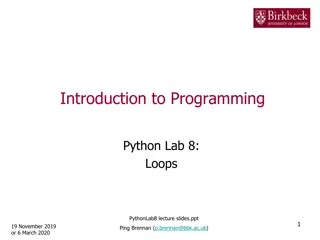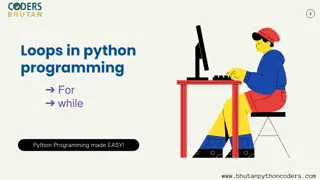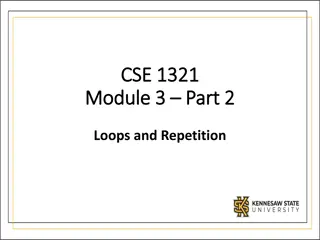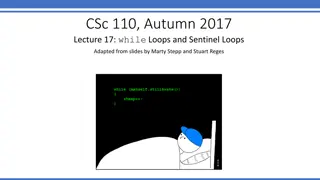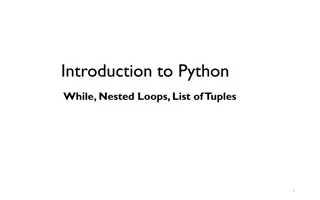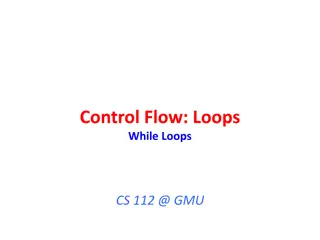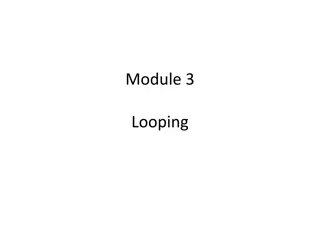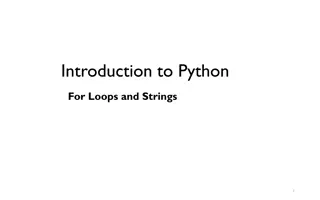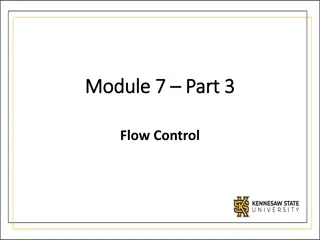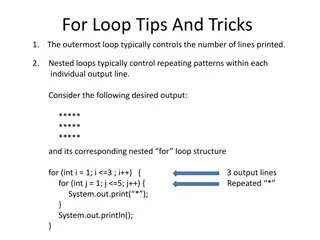Understanding For Loops in Python: A Comprehensive Overview
This content delves into for loops in Python, covering their syntax, practical applications, and differences from while loops. It explores how for loops can iterate over lists and perform actions a set number of times. Learn about the range() function and updating programs using for loops. Additionally, key string operations in Python such as concatenation, repetition, indexing, slicing, and iteration are discussed.
Download Presentation

Please find below an Image/Link to download the presentation.
The content on the website is provided AS IS for your information and personal use only. It may not be sold, licensed, or shared on other websites without obtaining consent from the author. Download presentation by click this link. If you encounter any issues during the download, it is possible that the publisher has removed the file from their server.
E N D
Presentation Transcript
CMSC201 Computer Science I for Majors Lecture 08 For Loops Prof. Katherine Gibson Prof. Jeremy Dixon www.umbc.edu
Last Class We Covered Lists and what they are used for How strings are represented How to use strings: Indexing Slicing Concatenate and Repetition 2 www.umbc.edu
Slicing Practice (Review) 1 2 3 4 0 5 6 7 8 T r u e G r i t -9 -8 -7 -6 -5 -4 -3 -2 -1 >>> grit[3:2] '' >>> grit[4:-4] ' ' >>> grit[-8:-4] 'rue' >>> grit[-4:] 'Grit' 3 www.umbc.edu
Any Questions from Last Time? www.umbc.edu
Todays Objectives To learn about and be able to use a for loop To understand the syntax of a for loop To use a for loop to iterate through a list To perform an action a set number of times To learn about the range() function To update our grocery program from last time! 5 www.umbc.edu
Looping 6 www.umbc.edu
Control Structures (Review) A program can proceed: In sequence Selectively (branching): make a choice Repetitively (iteratively): looping By calling a function focus of today s lecture 7 www.umbc.edu
Control Structures: Flowcharts focus of today s lecture 8 www.umbc.edu
Looping Python has two kinds of loops, and they are used for two different purposes what we re covering today The for loop: Good for iterating over a list Good for counted iterations The while loop Good for almost everything else 9 www.umbc.edu
String Operators in Python Operator Meaning Concatenation Repetition Indexing Slicing Length Iteration + * STRING[#] STRING[#:#] len(STRING) for VAR in STRING from last time 10 www.umbc.edu
Review: Lists and Indexing www.umbc.edu
Review: List Syntax Use [] to assign initial values (initialization) myList = [1, 3, 5] words = ["Hello", "to", "you"] And to refer to individual elements of a list >>> print(words[0]) Hello >>> myList[0] = 2 12 www.umbc.edu
Review: Indexing in a List Remember that list indexing starts at zero, not 1! 0 1 2 3 4 5 ??? ??? ??? ??? ??? ??? animals = ['cat', 'dog', 'eagle', 'ferret', 'horse', 'lizard'] print("The best animal is a", animals[3]) animals[5] = "mouse" print("The little animal is a", animals[5]) print("Can a", animals[4], "soar in the sky?") 13 www.umbc.edu
Review: Indexing in a List 0 1 2 3 4 5 The best animal is a ferret The little animal is a mouse Can a horse soar in the sky? cat dog eagle ferret horse lizard mouse animals = ['cat', 'dog', 'eagle', 'ferret', 'horse', 'lizard'] print("The best animal is a", animals[3]) animals[5] = "mouse" print("The little animal is a", animals[5]) print("Can a", animals[4], "soar in the sky?") 14 www.umbc.edu
Exercise: Indexing in a List Using the list names, code the following: Alice Bob Eve 1. Print Bob sends a message to Alice 2. Change the first element of the list to Ann 3. Print BobBobAnnEve 15 www.umbc.edu
Exercise: Indexing in a List 0 1 2 Using the list names, code the following: Alice Bob Ann Eve 1. Print Bob sends a message to Alice 2. Change the first element of the list to Ann 3. Print BobBobAnnEve print(names[1], "sends a message to", names[0]) names[0] = "Ann" print(names[1] + names[1] + names[0] + names[2]) # or print(names[1]*2 + names[0] + names[2]) 16 www.umbc.edu
for Loops: Iterating over a List www.umbc.edu
Remember our Grocery List? def main(): print("Welcome to the Grocery Manager 1.0") # initialize the value and the size of our list grocery_list = [None]*3 grocery_list[0] = input("Please enter your first item: ") grocery_list[1] = input("Please enter your second item: ") grocery_list[2] = input("Please enter your third item: ") print(grocery_list[0]) print(grocery_list[1]) print(grocery_list[2]) main() and that loops would make this part easier? 18 www.umbc.edu
Iterating Through Lists Iteration is when we move through a list, one element at a time Instead of specifying each element separately, like we did for our grocery list Using a for loop will make our code much faster and easier to write 19 www.umbc.edu
Parts of a for Loop Here s some example code let s break it down myList = ['a', 'b', 'c', 'd'] for listItem in myList: print(listItem) 20 www.umbc.edu
Parts of a for Loop Here s some example code let s break it down initialize the list myList = ['a', 'b', 'c', 'd'] the list we want to iterate through how we will refer to each element for listItem in myList: print(listItem) the body of the loop 21 www.umbc.edu
How a for Loop Works In the for loop, we are declaring a new variable called listItem The loop will change this variable for us The first time through the loop, listItem will be the first element of the list ('a') The second time through the loop, listItem will be the second element of the list ('b') And so on 22 www.umbc.edu
Example for Loop We can use a for loop to find the average from a list of numbers nums = [98, 75, 89, 100, 45, 82] total = 0 # we have to initialize total to zero for n in nums: total = total + n # so that we can use it here avg = total / len(nums) print("Your average in the class is:", avg) 23 www.umbc.edu
Quick Note: Variable Names Remember, variable names should always be meaningful And they should be more than one letter! There s one exception: loop variables for n in nums: sum = sum + n You can, of course, make them longer if you want 24 www.umbc.edu
Accessing List Elements Directly What do you think this code does? myList = [1, 2, 3, 4] for listItem in myList: listItem = 4 print("List is now:", myList) List is now: [1, 2, 3, 4] Changing listItem does not change the original list! It s only a copy of each element 25 www.umbc.edu
Copying the List Elements The for loop from before is essentially this code: listItem = myList[0] listItem = 4 listItem = myList[1] listItem = 4 # and so on... You can see now why editing listItemdoesn t change the actual contents of myList 26 www.umbc.edu
Strings and for Loops Strings are represented as lists of characters So we can use a for loop on them as well music = "jazz" j a z z What will this code do? for c in music: print(c) The for loop goes through the string letter by letter, and handles each one separately 27 www.umbc.edu
Practice: Printing a List Given a list of strings called food, use a for loop to print out that each food is yummy! food = ["apples", "bananas", "cherries", "durians"] # for loop goes here for f in food: print(f, "are yummy!") apples are yummy! bananas are yummy! cherries are yummy! durians are yummy! 28 www.umbc.edu
The range() function www.umbc.edu
Range of Numbers Python has a built-in function called range() that can generate a list of numbers cast it to a list to force the generator to run ex = list(range(0, 10)) print(ex) like slicing it s UP TO (but not including) 10 [0, 1, 2, 3, 4, 5, 6, 7, 8, 9] 30 www.umbc.edu
Syntax of range() range(START, STOP, STEP) the number we want to start counting at how much we want to count by the number we want to count UP TO (but will not include) the name of the function 31 www.umbc.edu
Using range() in a for Loop We can use the range() function to control a loop through counting for i in range(0, 20): print(i + 1) What will this code do? Print the numbers 1 through 20 on separate lines 32 www.umbc.edu
Examples of range() There are three ways we can use range() With one number range(10) With two numbers range(10, 20) With three numbers range(0, 100, 5) 33 www.umbc.edu
range() with One Number If range() is given only one number It will start counting at 0 And will count up to (but not including) that number >>> one = list(range(4)) >>> print(one) [0, 1, 2, 3] 34 www.umbc.edu
range() with Two Numbers If we give it two numbers, it will count from the first number up to the second number >>> twoA = list(range(5,10)) >>> print(twoA) [5, 6, 7, 8, 9] >>> twoB = list(range(-10, -5)) >>> print(twoB) [-10, -9, -8, -7, -6] >>> twoC = list(range(10, 5)) >>> print(twoC) [] from a lower to a higher number range() counts up by default! 35 www.umbc.edu
range() with Three Numbers If we give it three numbers, it will count from the first number up to the second number, and it will do so in steps of the third number >>> threeA = list(range(2, 11, 2)) >>> print(threeA) [2, 4, 6, 8, 10] >>> threeB = list(range(3, 28, 5)) >>> print(threeB) [3, 8, 13, 18, 23] range() starts counting at the first number! 36 www.umbc.edu
Practice: The range() function What lists will the following code generate? 1. prac1 = list(range(50)) [0, 1, 2, 3, 4, 5, ..., 47, 48, 49] a list from 0 to 49, counting by 1 2. prac2 = list(range(-5, 5)) [-5, -4, -3, -2, -1, 0, 1, 2, 3, 4] 3. prac3 = list(range(1, 12, 2)) [1, 3, 5, 7, 9, 11] 37 www.umbc.edu
Counting Down with range() By default, range() counts up But we can change this behavior If the STEP is set to a negative number, then range() can be used to count down >>> downA = list(range(10, 0, -1)) >>> print(downA) [10, 9, 8, 7, 6, 5, 4, 3, 2, 1] >>> downB = list(range(18, 5, -2)) >>> print(downB) [18, 16, 14, 12, 10, 8, 6] 38 www.umbc.edu
Using range() in for Loops When we use the range() function in for loops, we don t need to cast it to a list The for loop handles that for us 5 10 15 20 25 print("Counting by fives...") for num in range(5, 26, 5): print(num) call the range() function, but don t need to cast it to a list 39 www.umbc.edu
Coding Practice www.umbc.edu
Practice: Odd or Even? Write code that will print out, for the numbers 1 through 20, whether that number is even or odd Sample output: The number 1 is odd The number 2 is even The number 3 is odd 41 www.umbc.edu
Practice: Odd or Even? Write code that will print out, for the numbers 1 through 20, whether that number is even or odd for num in range(1,21): # if odd, will be 1 (which is True) if (num % 2): print(num, "is odd") # if even, divides cleanly into 2 else: print(num, "is even") 42 www.umbc.edu
Practice: Update our Grocery List! Remember from last time What would make this process easier? Loops! Instead of asking for each item individually, we could keep adding items to the list until we wanted to stop (or the list was full ) Let s do this! 43 www.umbc.edu
Announcements Lab 3 is being held this week! Make sure you attend your correct section Homework 4 is out Due by Monday (February 29th) at 8:59:59 PM Homeworks and Pre-Labs are on Blackboard Homework 1 grades have been released 45 www.umbc.edu
Practice Problem Write a program that asks the user for input: The height and width of a parallelogram Print a parallelogram with those dimensions to the user s screen bash-4.1$ python lec8_practice1.py What is the height of your parallelogram? 4 What is the length of your parallelogram? 7 ******* ******* ******* ******* 46 www.umbc.edu
Practice Problem Write a program that asks the user to enter a positive integer, and calculates the sum of 12 + 22 + ... + n2 and prints it to the screen For example, if the user entered 5, the program would calculate 12 + 22 + 32 + 42 + 52 = 1 + 4 + 9 + 16 + 25 = 55 bash-4.1$ python lec8_practice2.py Enter a positive integer: 4 The sum of the first 4 squares is 30. 47 www.umbc.edu



